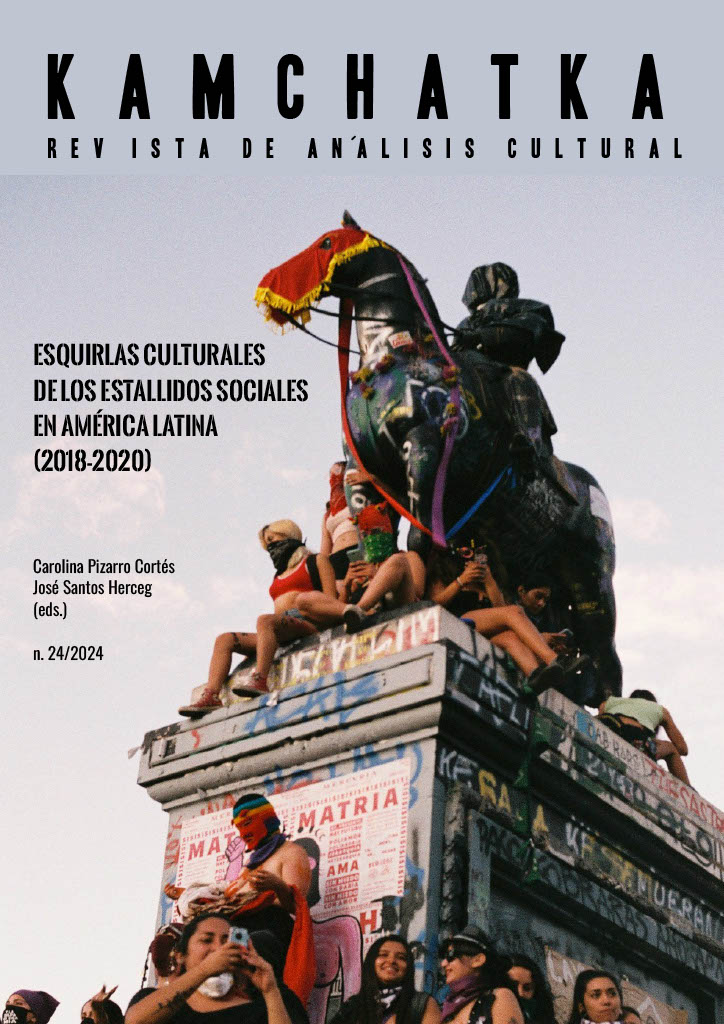(Animal) Becomings and trans*formations of Salón de belleza among Mario Bellatin’s artistic project
DOI:
https://doi.org/10.7203/KAM.24.28089Keywords:
Latin American Literature, Mario Bellatin, becoming-animal, trans*, 21st Century Abstract
Abstract
Although the becoming-animal (in Deleuze and Guattari’s formulation) is one of the most frequently used topics in Latin American animal literature, the use
that the Peruvian-Mexican writer Mario Bellatin makes of it (re)situates his artistic project in a present signed by the changes in the functioning of the publishing market, the transformation of the role of literature and the exhaustion of the globalizing project and the consequent crises (political, economic, environmental, etc.).
From a perspective that combines philosophical analysis (animal studies and studies of animality) with sociological analysis (materialist analysis of modes of production, circulation, and reception), we propose a critical intervention that allows us to elucidate not only the function of becomings-animal in the Bellatin’s writing system and their entanglement with trans*, artistic, and literary languages, but also their place within Latin American literature of the 21st century.
 Downloads
Downloads
 References
References
AMATO, Mariana (2012). “La vida en el umbral, una poética”. Ortega, Julio y Dávila, Lourdes (comp.). La variable Bellatin. Navegador de lectura de una obra excéntrica. Veracruz: Universidad Veracruzana: pp. 35-70.
ARTIGAS CARRILLO, Franco Andrés (2023). “Corpografías sexodisidentes como visibilización de las liminalidades biopolíticas en Salón de belleza de Mario Bellatin”. Árboles y Rizomas, vol. V, n.º 1: 58-69. https://doi.org/10.35588/ayr.v5i1.5913
BÁDER, Petra (2014). “La metamorfosis del espacio en Salón de belleza de Mario Bellatin”. Colindancias: Revista de la Red de Hispanistas de Europa Central, n.º 5: pp. 205-214.
BELLATIN, Mario (1999). Salón de belleza. México: Tusquets.
BELLATIN, Mario (2005). Obra reunida. México: Alfaguara.
BELLATIN, Mario (2013). Gallinas de madera. México: Sexto Piso.
BELLATIN, Mario (2019). Un kafkafarabeuf. Ilustraciones de Claudio Romo. Chile: Erdosain Ediciones.
BELLATIN, Mario (2020 a). El libro, la mola, el monstruo. La Plata: Club Hem.
BELLATIN, Mario (2020 b). El palacio. Buenos Aires: Editorial Marciana.
BELLATIN, Mario (2020 c). Ojos flotantes, mojados, limpios. Ilustrado por Sebastián Maturano. Córdoba (Argentina): Borde Perdido Editora.
BOLLINGTON, Lucy (2018). “Animality, Sexuality and the Politics of Death in Mario Bellatin’s Salón de belleza”. Bulletin of Latin American Research, vol. 37, n. º 4: pp. 479-492. https://doi.org/10.1111/blar.12670
CHERRI, Leo (2021). “La salud del Neobarroco: Salón de belleza de Mario Bellatin”. RECIAL, vol. XII, n.º 30: pp. 119-139. https://doi.org/10.53971/2718.658x.v12.n20.35975
CUARTAS, Juan Pablo (2021). “Salón de belleza de Mario Bellatin: la preparación de la novela”. Orbis Tertius, vol. XXVI, n. º 33: pp. 1-11. https://doi.org/10.24215/18517811e191
DELEUZE, Gilles y GUATTARI, Felix (1988). Mil mesetas. Capitalismo y esquizofrenia. Valencia: Pre-Textos.
FAUSTO, Juliana (2023). La cosmopolítica de los animales. Buenos Aires: Cactus.
GALLEGO CUIÑAS, Ana (2022). Cultura literaria y políticas de mercado. Editoriales, ferias y festivales. Berlín-Boston: De Gruyter.
GIORGI, Gabriel (2014). Formas comunes. Animalidad, filosofía, biopolítica. Buenos Aires: Eterna Cadencia.
HALBERSTAM, Jack (2018). Trans*: una guía rápida y peculiar de la variabilidad de género. Traducción de Javier Sáez. Barcelona-Madrid: Egales.
HAYWARD, Eva y WEINSTEIN, Jami (2015). “Introduction: Tranimalities in the age of trans* life”. Transgender Studies Quarterly, vol. 2, n. º 2: pp. 195-208. https://doi.org/10.1215/23289252-2867446
LÓPEZ ALFONSO, Francisco José (2015). Mario Bellatin. El cuadernillo de las cosas difíciles de explicar. Cuadernos de América sin Nombre, 37.
MÜLLER, Gesine y Loy, Benjamin (eds.) (2023). Post-Global Aesthetics. 21st Century Latin American Literatures and Cultures. Berlin-Boston: De Gruyter.
PALAVERSICH, Diana (2003). “Apuntes para una lectura de Mario Bellatin”. Chasqui, vol. 32, n. º 1: pp. 25-38.
PEÑA, Estefanía (2008). “Transgresión y significación de espacio en Salón de belleza de Mario Bellatin”. RELEA: Revista Latinoamericana de Estudios Avanzados, vol. 14, n. º 27: 235-254.
PITOL, Sergio (2014). El tercer personaje. Barcelona: Anagrama.
RAGGIO MIRANDA, Salvador Luis (coord.) (2014). Salón de anomalías. Diez lecturas críticas acerca de la obra de Mario Bellatin. Lima: Ediciones Altazor.
SÁNCHEZ CRUZ, Jorge (2021). “Suspensión de género: travestismo y la cuestión de lo trans en Salón de belleza (1999)”. La ventana, n. º 54: pp. 304-325.
YELIN, Julieta (2015). La letra salvaje. Ensayos sobre literatura y animalidad. Rosario: Beatriz Viterbo Editora.
YELIN, Julieta (2020). Biopoéticas para las biopolíticas. El pensamiento literario latinoamericano ante la cuestión animal. Pittsburgh: Latin American Research Commons.
Downloads
Published
How to Cite
-
Abstract5
-
Artículo PDF (Español)0
Issue
Section
License
Copyright (c) 2024 Marta F. Extremera

This work is licensed under a Creative Commons Attribution-NonCommercial 4.0 International License.
This journal provides an immediate free access to the content on the principle that freely make investigation available to the public, which promotes an increased global knowledge exchange.
Unless otherwise indicated, texts published in this journal are under the license Attribution-NonComercial 4.0 by Creative Commons. These texts may be copied, distributed and publicly communicated whenever the publication’s author and title are quoted and whenever they are not used for commercial purposes. In any case, intellectual property of the articles and its potential economic rights entirely belong to its authors.
The full license can be consulted on https://creativecommons.org/licenses/by-nc/4.0/. We encourage authors to disseminate papers published in Kamchatka. Journal of cultural analysis electronically, in institutional digital repository or in their websites.





